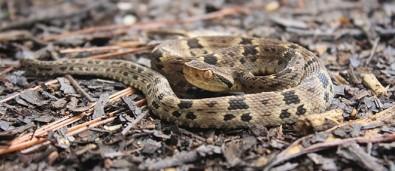A study conducted in Brazil showed protective effects of this flavonoid against bleeding and inflammation due to snakebite.

Credit: Frederico de Alcântara Menezes / Instituto Butantan
Rutin, a bioflavonoid (plant pigment) found in certain vegetables and fruits, protects mice against snake venom by minimizing bleeding and inflammation, according to a study performed at the Butantan Institute, a research institution belonging to the government of São Paulo State in Brazil.
The research focused on methods to combat the effects of envenomation by the lancehead pit viper Bothrops jararaca, which is responsible for approximately 70% of snakebites in the state, and was conducted by Marcelo Larami Santoro, Ana Teresa Azevedo Sachetto and Jaqueline Gomes Rosa at Butantan Institute’s Physiopathology Laboratory, with funding from São Paulo Research Foundation – FAPESP, Brazil’s National Council for Scientific and Technological Development (CNPq) and the Brazilian Ministry of Education’s Office for the Improvement of Higher Education Personnel (CAPES).
The results were published in the journal PLOS Neglected Tropical Diseases.
Rutin is found in apples, bell peppers, chili peppers, blackberries, buckwheat, cherries, citrus, figs, grapes (and wine), persimmons, raspberries and strawberries, as well as black tea and green tea.
In plants, rutin and other flavonoid pigments attract pollinator insects, filter ultraviolet rays and fix nitrogen. Flavonoids also have anti-oxidant properties and participate in defense mechanisms, helping prevent attacks by insects and microbes.
Rutin specifically is known to be a powerful anti-oxidant and anti-inflammatory agent.
Antivenom therapy counteracts the main effects of snakebite, but there is no known treatment for the most frequent secondary complications. Toxins present in B. jararaca’s venom can trigger both bleeding and adverse clotting. The toxins also cause a hazardous imbalance in cellular reduction-oxidation (redox) reactions.
“The mechanisms underlying clinical complications in patients bitten by B. jararaca are poorly understood, and antivenom therapy has a limited capacity to treat the entire range of complications that may be caused by snakebites,” Santoro said.
“For example, the snake’s venom increases the activity of tissue factor, a protein that plays a key role in the clotting process and is present in tissue, blood platelets and monocytes.”
Tissue factor is activated by tissue exposure in cuts or wounds to assist blood clotting and is the primary cellular initiator of clotting after blood vessel injury.
In the case of snake envenoming, tissue factor is activated even in the absence of a wound, forming clots that impair blood circulation and can become large enough to lead to embolisms, blocking a vein or artery and causing tissue necrosis.
The researchers, therefore, reasoned that inhibiting tissue factor activity and making it return to its original condition could be a way to treat thrombosis, a significant secondary complication of viper bite. “Envenomation doesn’t necessarily augment tissue factor, but it does heighten tissue factor activity,” Santoro said.
Oxidative stress
An enzyme called PDI controls tissue factor activity, and rutin is known to inhibit the action of PDI.
“Envenoming by B. jararaca causes clotting problems due to an increase in tissue factor activity. This activity is controlled by PDI, and we know that rutin can inhibit PDI. It occurred to us that rutin could be used to avoid tissue factor expression in cases of viper bite to reduce secondary complications such as adverse blood clotting,” Santoro said.
To test their hypothesis, the researchers conducted experiments in vitro and in mice. In the former, they dissolved B. jararaca venom in a rutin solution and discovered that the rutin has a beneficial effect against oxidative stress, a biological condition involving an imbalance between the production of free radicals and the organism’s ability to counteract their harmful effects. Oxidative stress is another secondary complication of envenomation by snakebite.
The in vivo experiments involved 72 mice divided into three time-based groups of 24, each of which were randomly allocated to four groups of six. A saline solution was administered to all four groups. The control group received only saline. The second, third and fourth groups received injections of B. jararaca venom, rutin alone, and venom plus rutin, respectively.
Three, six and 24 hours after the injections, the animals were euthanized for the collection of blood and tissue samples. The researchers analyzed these samples to investigate the effects of rutin on the physiopathological events triggered by the snake venom.
“Tissue factor activity increases in response to envenomation. In the group that received venom plus rutin, we found that rutin reduced clotting and thereby protected the organism from the venom’s clotting action,” Santoro said. “However, we were unable to identify the target of rutin or how it acted in the organism to control tissue factor activity.”
He added that future studies will be necessary to understand how rutin works once the venom has triggered the cascade of physiological events concerned and to further investigate the therapeutic effects of administering rutin with antivenom.
“Our research suggests rutin has great potential as an ancillary drug to be taken with antivenom for the treatment of snakebite, especially in countries where antivenom is in short supply,” Santoro said.
###
About São Paulo Research Foundation (FAPESP)
The São Paulo Research Foundation (FAPESP) is a public institution with the mission of supporting scientific research in all fields of knowledge by awarding scholarships, fellowships and grants to investigators linked with higher education and research institutions in the State of São Paulo, Brazil. FAPESP is aware that the very best research can only be done by working with the best researchers internationally. Therefore, it has established partnerships with funding agencies, higher education, private companies, and research organizations in other countries known for the quality of their research and has been encouraging scientists funded by its grants to further develop their international collaboration. For more information: http://www.
Media Contact
Joao Carlos Silva
[email protected]
55-113-838-4381
Original Source
http://agencia.
Related Journal Article
http://dx.




